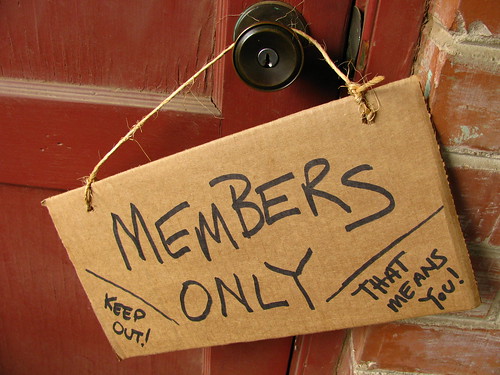 Oh no, here it comes. When times are tough for Community Benefit Organizations, a single article like this one (originally from the Wall Street Journal, then quoted at the Chronicle of Philanthropy) can be enough to send boards and EDs scurrying to get ahead of the latest new fundraising fad.
Oh no, here it comes. When times are tough for Community Benefit Organizations, a single article like this one (originally from the Wall Street Journal, then quoted at the Chronicle of Philanthropy) can be enough to send boards and EDs scurrying to get ahead of the latest new fundraising fad.
Membership is by no means a new fad. It is one that is used by many high profile organizations – museums, Nonprofit Resource Centers, public broadcast stations. And it can indeed provide a fairly reliable stream of money.
However, before the study quoted in the WSJ gets your board all fired up to institute a membership program, there are words of caution you may want to heed.
Caution#1:
Membership dues are paid annually.
Result: While non-member donors are accustomed to giving throughout the year, members are used to being asked / giving once a year – period.
Caution #2:
Memberships tend to be inexpensive.
Result: Not only do funds from members only come in once a year, their giving levels barely graze the bottom wrung of a typical annual appeal.
Caution#3:
Almost by definition, membership is transactional.
Members provide financial support in exchange for a tangible set of benefits – free admission, a monthly arts calendar, discounts on classes, a Pavarotti DVD set.
Result: While members certainly feel supportive of the cause, members can also be heard saying, “I’m considering not renewing my membership this year. I rarely use it…” Their thoughts about their membership are not first and foremost as a donor who is supporting a cause, but as the user of a product or service. The transactional nature of the relationship is further reinforced by ongoing payment-due renewal notices, that are worded to focus on what members will no longer receive if they allow that membership to lapse.
Caution #4:
“Transactions” require more work for the organization than straight donations.
Result: In addition to standard fundraising costs, membership entails expenses for all the “stuff” the member receives.
Caution #5:
Net proceeds are all that count.
Result: Once you factor in the cost beyond the actual member perks – the staff time to secure and manage those items, as well as the ongoing “renewal” notices – might more money be raised if the staff were doing something other than ordering mugs or creating “member events?”
As we summarize the revenue side of the membership equation, we see the following:
Membership is once-a-year, low-dollar revenue from purchasers who, while supportive of the cause, expect to receive “stuff” in exchange for their donation. Membership is transactional rather than engaging, and those transactions require more staff time than other donation programs.
In addition to these financial cautions, there is one additional caution that relates not to revenues, but to the very mission of the organization.
Caution #6:
Membership is defined by exclusivity. Either one is a member or not.
Result: Effecting community change requires a culture of INclusivity. It requires as many hands on deck as possible. It requires that an organization provide service to anyone who needs it, regardless of (and often specifically in contrast to) their ability to pay for that service.
How does it impact a museum’s mission to “provide education and foster appreciation in the community” if they provide discounts only to those who can afford membership? Does the mission de facto become “to provide education and foster appreciation only among those who can afford it?”
The same question holds true for a Nonprofit Resource Center whose for-pay workshops are open to anyone, while free workshops are offered only as a perk for its members. Does that Nonprofit Resource Center’s mission de facto become “to serve our members,” rather than “to serve the community?”
The Answer
When we ask, “What are the pros and cons of a membership campaign?” we are considering one approach in a vacuum. And while the pros of that one approach may outweigh the cons, that still doesn’t make it the best choice among a whole realm of options.
So what’s the answer? The answer requires that we consider the range of options for raising money to support your cause, and choose your fundraising strategy by weighing each of those tactics not only against objective criteria, but against each other.
• How much might each approach raise?
• How much work will it take?
• Will those donors become real friends?
• Etc.
Add up and compare your answers and see which comes out on top.
Is it membership? I didn’t think so.
Are you making your decisions in a vacuum? This easy-to-use tool will help you make more effective decisions!
